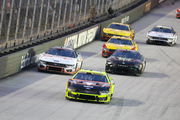

NASCAR race tracks often have a story behind them, some good, some bad. Since its inception, NASCAR has visited numerous American racetracks. Some have shut down due to various factors, while some have been completely isolated from NASCAR racing. An example of the latter would be the historic Fonda Speedway. Unlike many other tracks, the New York-based race track is still used for racing, but since 1968, NASCAR has yet to approach it.
Watch What’s Trending Now!
Established in 1953, the 0.5-mile-long Fonda Speedway began hosting Cup Series races in 1955. Hosting Modified, Sportsman, and Pro Stock races, the race track became known as the ‘Track of Champions’ due to its intense competition. Alas, its reputation couldn’t attract Cup races for a prolonged period.
ADVERTISEMENT
Fonda Speedway’s fast progress
Fonda Speedway has yet to be a big part of NASCAR history. In the two decades of the 1950s and 1960s, it hosted a mere four NASCAR races. However, that was enough for racing enthusiasts to deem it one of the country’s most dangerous tracks.
Known as the Montgomery County Fairgrounds in its nascent stage, the track attracted less crowd than expected due to the region’s lack of interest in racing. To fuel the desire to race, track promoter Jack Kochman urged the officials to convert the racing track from a playground for stuntmen, initiated events that saw modified cars from the New England region and named the racing series Speedway Corporation of America.
While the racing tourney didn’t work out to put Montgomery County Fairground’s name alongside some of the best racetracks in America, a huge impending investment funded the large-scale improvements in the arena. Following the changes, the race track became known as the Fonda Speedway.
ADVERTISEMENT
NASCAR’s establishment in 1948 coincided with the Fonda Speedway’s prominence. As the 1950s decade began, Fonda Speedway started hosting stock car races by inviting drivers. This attracted a lot of fans and, most importantly, sponsors who rushed to find representation in a region where racing was booming. Soon after, the track earned the moniker, ‘The Track of Champions.’
ADVERTISEMENT
Watch This Story: The Uncertain Road Ahead Matt Dibenedettos 2024 NASCAR Journey
ADVERTISEMENT
Top Stories
Jeff Gordon’s NASCAR Rival Issues Public Verdict Years After His Apology

Ross Chastain Recalls the Relentless Grind That Kept His NASCAR Dream Alive After Sponsorship Spin-off

Richard Childress’ Champion Driver Joins Forces with HMS Crew Chief to Make Last Minute Chili Bowl Entry

Mark Martin Hails New NASCAR Hall of Famer’s Unmatched Racecraft Legacy That Outsmarts Rivals

NASCAR Insider Shuts Down Fan Hopes For 36-race Points Format As Playoff Decision Remains In Limbo

Fonda quickly became one of NASCAR’s most dangerous tracks
NASCAR couldn’t simply sit back and watch as the steady progress attracted it to Fonda. In 1955, NASCAR agreed with the speedway management to organize a NASCAR Grand National Race at Fonda Speedway. As only 30 cars were allowed to race at the track for safety reasons, the rest had to participate in a consolation race. Unfortunately, the consolation race was ex-Army veteran Otis Eaton’s final race.
After starting well in the race, Eaton suddenly lost control of his car and tumbled twice before another driver collided with the car’s roof uncontrollably. The incident left multiple serious head injuries on Otis, and the following morning, he was declared dead.
ADVERTISEMENT
Racing returned to the track weeks after Eaton’s death with the Sportsman division cars. On the same day, Jim Luke’s car blew a tire, and the tire was airborne. It hit some of the spectators, among which a middle-aged male was announced dead. Fortunately, this motivated race track authorities to add protection for the crowd in upcoming races.
A year later, in 1956, tragedy struck again. Munsville native Lou Smith wrecked his #62 car on the front stretch after flipping violently following a collision with the hub rail. Smith suffered severe injuries and had to undergo brain surgery as well. Lou succumbed to his painful injuries later.
However, this didn’t demotivate NASCAR as it returned for a Sportsman car event again. New England racing veteran Walter Pepper Eastman’s car flipped on the track thrice in the race and had to be admitted to the hospital immediately. However, he couldn’t survive the injuries and passed away soon after.
ADVERTISEMENT
Tragedy has always clouded the Fonda Speedway. However, there have been times when it was a host to some of the best NASCAR drivers battling each other.
Read More: Dale Earnhardt Jr Puts Debate to Rest as Landon Huffmans’ Crew Brings Forth a Common Disagreement
ADVERTISEMENT
ADVERTISEMENT
ADVERTISEMENT

